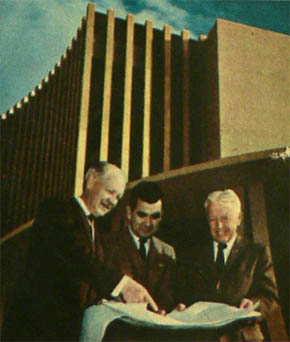Conversation with Wence Sarmiento: Architect of the AAA
 |
| Sarmiento (center) at the Pheonix Financial Center in 1967 |
The American Automobile Association (AAA) Building was designed in 1976 by internationally known architect Wenceslao (Wence) Sarmineto. A native of Peru, Sarmiento graduated from the National School of Engineering in Lima in 1946. While visiting his sister-in-law in St. Louis in 1950, Sarmiento had a minor car accident with architect W.G. Knoebel. Discovering they were both in the same profession, Knoebel invited Sarmiento to meet his employer Joseph B. Gardener, President of the Bank Building and Equipment Company (BBEC). Soon after the meeting with Gardener, Sarmiento was offered the position of chief designer for the BBEC, headquartered in St. Louis. He became a driving force behind revolutionizing the look and feel of bank buildings constructed in postwar America between 1952 and 1964. At the end of his tenure with the BBEC, Sarmiento started his own firm and remained in St. Louis until 1978 when he relocated to California.
After the announcement of the potential threat to demolish the AAA Building for a CVS store, Landmarks Association contacted the 89 year old Sarmiento who still resides in Southern California. Our conversations with the architect occured over the course of the Winter of 2012. Our office asked several questions regarding his influences, design philosophy and the movement away from the International Style. The following is correspondence with Sarmiento over a month that has been edited for length and clarity.
As a young man starting your career, who were your influnces?
Sarmiento: Frank Lloyd Wright, Pierre Luigi Nervi and the San Francisco Golden Bridge.
I read that you were a draftsman with the firm of Oscar Niemeyer. How long were you there and what projects were you involved with at the firm?
Sarmiento: I was an unknown employee drawing doors & windows sections. It was one stop while traveling around the main South American Cities.
How did your design philosophy change over time?
Sarmiento: Design philosophies are just blabbering for the media. Architecture is factual. People modus vivendi changes as time goes by. Architecture follows.
What was your inspiration behind your design of the AAA Building and the similarly designed Catholic Chancery on Lindell Avenue constructed in 1965? Why did you design the site the way you did?
Sarmiento: Both buildings were executive offices. Pedestrian traffic was minimum. Form follows function dictated a formal form, thus the set back from the street and the symmetric axis
The AAA Building appears a move back to classical design.
Sarmiento: Yes, you are correct. The modern architecture of the 20 Century formalized in the German Bauhaus by Walter Gropius and his followers, who departing from the decorated Baroque, brought function as the purpose in Architecture, which Louis Sullivan's motto: "Form follows function" gave a soul to the American Architecture. But the form was simplified as purity abstraction by the followers of Van der Rohe. "Less is more" was the postulate of the purist. With these radicals conceptions all glass houses appeared and sensationalistic "less is more" perverted "form follows function". In the middle of the 20 Century, American architecture was at a cross roads, when the genius of Frank Lloyd Wright energized it with his "organic architecture" in which the natural beauty of materials enhanced the form and "form follows function" continued its dictum.
I was lucky to be in the middle of the 20 Century in America and felt these intellectuals currents conceived by the human race under the drama of World War II struggling for expression in Science (mathematics, astronomy, physics, engineering) and Arts (architecture, music, sculpture, painting, literature). I felt strongly that the art in architecture was being overtaken by improper use of necessary engineering, and architecture became more engineering and less art. I adhered to the greek concept of architecture as an art, and wrote: "Architecture is the art to shelter human activities with a balance of engineering and sculpture" Today in the 21 Century I believe the same. Yes, we need always engineering: structures to resist gravity, earthquakes, hurricanes; envelopes to resist climate, weather. Fortunately, engineering and new materials are constantly improving and the structure and the envelope may give more freedom to art. And so . . . "form follows function" shall go on.
What other buildings did you design in the St. Louis metro area?
Sarmiento: Maryville College's Administration Building. The Clayton Federal Building.
Of all your designs across the world which are your favorites?
Sarmiento: None
To learn more about the life and work of Wence Sarmiento, read his biography on Defining Downtown at Mid Cenutry: The Architecture of the Bank Building and Equipment Corporation.
